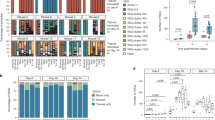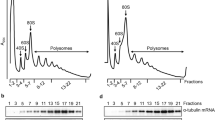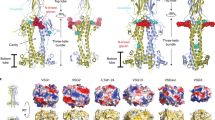Abstract
THE major pathogenic African (salivarian) trypanosomes can evade the immune response through a process of antigenic variation (reviewed in ref. 1). Mainly due to Gray's work2,3, this variation is thought to be phenotypic—involving sequential expression of alternative genes and not resulting from contemporaneous mutation. The capacity for variation which exists within a clone, isolate or species, or within strains circulating within a geographical area, is uncertain (though probably extensive) and is relevant to an evaluation of the feasibility of developing vaccines. Although serotyping of trypanosome populations has been refined through the use of fluorescence methods4,5, there is a need to characterise the relevant antigens and investigate the molecular basis of antigenic variation. Other workers6–9 identified putative variable antigens and found them to be soluble glycoproteins10–12, probably located in the surface coat13,14. The antigen preparations obtained, however, were generally heterogeneous, frequently unstable or in low yield. A recent report15 described the complete purification in good yield of individual variant-specific surface antigens (VSSAs) from a series of clones of Trypanosoma brucei. The VSSAs seem to be the primary mediators of antigenic variation in T. brucei. Each anti-genically homogeneous trypanosome clone yields one predominant glycoprotein antigen composed of a single polypeptide chain (apparent molecular weight 65,000 as determined by sodium dodecyl sulphate (SDS)–polyacrylamide gel electrophoresis) and, depending on the variant, 7–17% (w/w) carbohydrate (unpublished results of J. G. Johnson). The VSSA seems to be the major or sole constituent of the surface coat and comprises 5–10% of the total cell protein. Studies of the amino acid sequences, carbohydrate constitution and cell-surface organisation of several VSSAs are in progress, and we report here the N-terminal amino acid sequences of VSSAs isolated from four closely related variants.
This is a preview of subscription content, access via your institution
Access options
Subscribe to this journal
Receive 51 print issues and online access
$199.00 per year
only $3.90 per issue
Buy this article
- Purchase on SpringerLink
- Instant access to full article PDF
Prices may be subject to local taxes which are calculated during checkout
Similar content being viewed by others
References
Vickerman, K., in Parasites in the Immunized Host: Mechanisms of Survival, Ciba Foundation Symp., 25 new series, 53–70 (Associated Scientific Publishers, Amsterdam, 1974).
Gray, A. R., J. gen. Microbiol., 41, 195–214 (1965).
Gray, A. R., Trans. R. Soc. Trop. med. Hyg., 69, 131–138 (1975).
Van Meirvenne, N., Janssens, P. G., and Magnus, E., Ann. Soc. belge. Med. trop., 55, 1–23 (1975).
Van Meirvenne, N., Janssens, P. G., Magnus, E., Lumsden, W. H. R., and Herbert, W. J., Ann. Soc. belge. Med. trop., 55, 25–30 (1975).
Williamson, J., and Brown, K. N., Expl Parasit., 15, 44–68 (1964).
Brown, K. N., and Williamson, J., Expl Parasit., 15, 69–86 (1964).
Le Page, R. W. F., Thesis, Univ. Cambridge (1968).
Lanham, S. M., and Taylor, A. E. R., J. gen. Microbiol., 72, 101–116 (1972).
Allsopp, B. A., Njogu, A. R., and Humphryes, K. C., Expl Parasit., 29, 271–284 (1971).
Niogu, A. R., and Humphryes, K. C., Expl Parasit., 31, 178–187 (1972).
Allsopp, B. A., and Njogu, A. R., Parasitology, 69, 271–281 (1974).
Vickerman, K., J. Cell Sci., 5, 163–194 (1969).
Vickerman, K., and Luckins, A. G., Nature, 224, 1125–1126 (1969).
Cross, G. A. M., Parasitology, 71, 393–417 (1975).
Brauer, A. W., Margolies, M. N., and Haber, E., Biochemistry, 14, 3029–3035 (1975).
Bridgen, J., Biochemistry, 15, 3600–3605 (1976).
Laursen, R. A., Eur. J. Biochem., 20, 89–102 (1971).
Bridgen, J., Graffeo, A., Karger, B. L., and Waterfield, M., in Instrumentation in Amino Acid Sequence Analysis (edit. Perham, R. N.), 111–145 (Academic, London, 1975).
Author information
Authors and Affiliations
Rights and permissions
About this article
Cite this article
BRIDGEN, P., CROSS, G. & BRIDGEN, J. N-terminal amino acid sequences of variant-specific surface antigens from Trypanosoma brucei. Nature 263, 613–614 (1976). https://doi.org/10.1038/263613a0
Received:
Accepted:
Issue date:
DOI: https://doi.org/10.1038/263613a0
This article is cited by
-
Why does immunity to parasites take so long to develop?
Nature Reviews Immunology (2010)
-
6 Å-Resolution X-ray structure of a variable surface glycoprotein from Trypanosoma brucei
Nature (1984)
-
Antigenic variation in the trypanosome
Nature (1982)
-
Cross-neutralization of two different trypanosome populations derived from a single organism
Nature (1982)
-
Point mutations during generation of expression-linked extra copy of trypanosome surface glycoprotein gene
Nature (1982)



